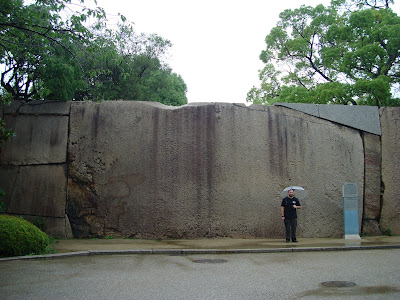Osaka Castle was built as a display of power by Toyotomi Hideyoshi after he achieved his goal of unifying Japan. One hundred thousand workers toiled for three years to construct an 'impregnable' granite castle, finishing the job in 1583. The present structure is a 1931 concrete reconstruction of the original, which was extensively renovated in 1997.
When we visited the castle it was raining hard and we only had one small umbrella. My right shoulder and Ken's left shoulder were getting soaking wet. We found this small shop (photograph below) on the way to the castle and Ken purchased two new clear umbrellas. The two old women in the shop laughed when Ken used the words "big" (ookii) and "small" (chiisai) in Japanese when referring to our umbrella and the ones he was purchasing.

Aoyamon Gate; this gate is located at the north entrance of Osaka Castle, built in the early Edo period, probably around 1620. Damaged in 1868 (massive fire) and in 1945 (bombings), the gate we saw was rebuilt in 1969.
Inner moat.
Ken standing in front of the stone known as Takoishi, literally, an octopus stone, which is the largest stone in the Osaka Castle, measuring 59.43 m2 (639.70 ft2) in surface area and 108t in estimated weight.
The eight-story keep (donjon) rises 39 meters (130 feet), with an observation platform on the top floor.
When purchasing tickets for attractions in Japan you often use vending machines instead of giving your money to a person.
Views from the observation platform.
We paid ¥300 and Ken donned samurai gear.
Lunch!
Ken is chiisai next to the castle.

















No comments:
Post a Comment